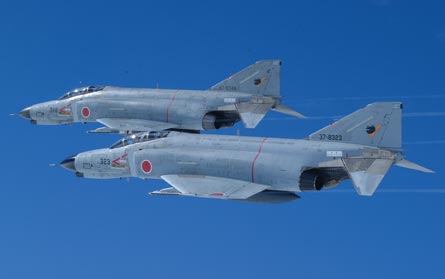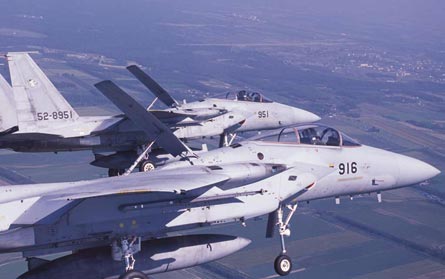Japan's government is examining whether to lift the lid on a decades-old ban on military exports.
The office of the prime minister has established a committee of high-ranking officials who are due to release by the end of the year the country's National Defence Programme Guidelines (NDPG), which will outline the policy stance on defence exports.
Japan's policy, "Three Principles on Arms Exports", has been in place since 1967 and effectively bans the export of Japanese military products, except for missile technology to the USA.
|
|---|
The policy also effectively prevents Japan from participating in the joint development of military aircraft. This is because any products or parts that Japan develops for a military aircraft would have to be removed if the aircraft were to be exported. As a consequence, Japanese defence manufacturers are restricted to only serving the domestic market, which is proving to be too limiting.
Japan's defence budget is capped at 1% of GDP, and since the late 1980s, GDP growth has stagnated. Japan's government in recent years has also been reducing the defence budget, say ministry of defence officials, who estimate the defence budget now stands at 0.9% of GDP.
Manufacturers such as Kawasaki Heavy Industries and Mitsubishi Heavy Industries have been keen to grow their defence business and are lobbying for an easing of the "three principles policy". They regard participation in international defence programmes as the way forward.
Joint development of military aircraft is a growing trend in the industry, says a senior executive at one of Japan's aerospace manufacturing conglomerates, who cites the Lockheed Martin F-35 and the Eurofighter Typhoon as top examples of international co-operation.
If Japan is unable to participate in such programmes, it will be unable to gain access to leading technologies, adds the executive.
|
|---|
REPORT
The Japan Machinery Federation, which counts Ishikawajima-Harima Heavy Industries, KHI and MHI among its members, released a report in March recommending to government that the three principles policy be eased.
"The US and major European countries acquire advanced defence equipment through international development and production, including fighter and [military] transport aircraft," says the federation. "It is inefficient to develop and produce small quantities of sophisticated, expensive equipment autonomously and very difficult to acquire equipment with required performance levels in a timely and affordable manner."
Defence contractors have been attempting to meet the country's needs by developing military aircraft indigenously or through licensed production, the federation adds. "However, conditions of defence equipment development and production have significantly changed," it says, adding: "Japan's defence industries cannot provide effective defence equipment through indigenous efforts limited to an isolated defence market, or licensed production with restrictions on technology transfer."
The Democratic Party of Japan came to office in September 2009, ending 54 years of Liberal Democratic rule. The new government is becoming more open to the idea of easing the export ban, because the defence budget is constrained and the dual approach - of indigenous aircraft development and licensed production of foreign aircraft - is proving to be too costly. Poor procurement practices have exacerbated the problem.
In terms of indigenous aircraft, the ministry of defence has funded the ShinMaywa US-2 search and rescue aircraft, the Kawasaki XP-1 maritime patrol aircraft and the Kawasaki XC-2 military transport. But because Japanese military aircraft are built for the local military only and, in some instances, are niche products, local manufacturers are unable to produce enough units to achieve economies of scale.
ShinMaywa, for example, has delivered only four US-2s to the Japan Self-Defence Force and has only one aircraft on order, for delivery in 2012.
If Japanese manufacturers could export, it would increase production volumes and cut per unit costs. These savings could be passed on to the government through lower prices.
Japan's ministry of defence has also established a committee to examine "commercialisation of military aircraft", which means developing commercial variants. Some Japanese aircraft makers are already moving in this direction. ShinMaywa, for example, has a concept for a firefighting variant of its US-2. KHI is looking at developing a commercial cargo variant of its XC-2 military transport aircraft.
In terms of Japan's licensed production of foreign aircraft, this is expensive because Japanese manufacturers have to pay a licence fee. "We also have to train people and invest in equipment," says a senior executive at one of Japan's aerospace conglomerates.
Licensed production was popular in the past because it provided work to local industry, gave Japan the ability to maintain the aircraft and it was thought it would lead to technology transfer. But it is questionable how much technology is transferred under licencing deals and now that Japan's defence budget is constrained, cost is becoming an issue. The Mitsubishi F-2, for example, is a derivative of the Lockheed Martin F-16 and is more expensive than the F-16. The F-2 has a larger, concurred wing, but these design changes contributed to the higher costs. This aircraft was jointly developed with Lockheed, but Japan gained less in the way of technology transfer than it had hoped as US lawmakers placed restrictions to limit the transfer of technology.
The issue of costs came to a head again last year when the government decided to stop buying Boeing AH-64D Apache attack helicopters assembled by Fuji Heavy Industries, citing the high costs involved: each helicopter had cost a lot more than had originally been forecast.
Japan's system of "cost-plus contracts" was a major factor in the price escalation. "A large proportion of Japan's defence budget is spent via cost-plus contracts that actually rewards inefficiency," says the American Chamber of Commerce in Japan. The chamber, in its report into Japanese government procurement, recommends "adoption of a more fixed-price, performance-based contracts, which will provide incentives to the industry to cut costs."
In the case of the Apache helicopters, FHI has responded to the order cancellation by suing the government, putting an end to the cosy relationship that once existed between the government and Japan's aerospace industry. FHI is claiming it deserves damages because it has invested millions in the Apache production line and already paid a licence fee.
This highlights another issue with Japan's procurement system. "The payment schedules, used by the ministry of defence for production programmes, are not realistic for modern manufacturing," says the American Chamber of Commerce in Japan. "While the standard payment is weighed toward the end of the programme, most production programmes typically encounter greater costs earlier," it says. "This increases financing costs to the companies, which must subsequently add costs to recoup additional costs."
SMALL LOTS
Payment is small upfront because the government procures aircraft in small lots, one year at a time in keeping with the country's budget process. The explanation for this is that the government is unable to commit to spending beyond the next budget.
But buying aircraft piecemeal makes the overall purchase more expensive. The acquisition, for example, of 213 Boeing F-15 fighters over 20 years of single-year, small lots, greatly added to the cost, says the chamber.
The chamber also cites the example of the Maritime Self-Defence Force buying two Aegis missile defence systems for about the same price that South Korea paid for three. "Japan paid a large premium to buy in two separate contracts rather than group [the deal] together in a single contract," it adds.
If Japan were to decide that it wanted to participate in international military programmes, it would have some leverage because its is a major customer.
The government is preparing to issue a request for proposals for 40-50 aircraft for delivery from 2015 under the FX programme. There is also the follow-on FXX programme, a larger requirement for more than 100 fighters to replace some of the air force's older F-15s.
A number of aircraft makers say they are open to having Japan as a joint development partner if the country eases its three principles policy.
Japan has already proved itself to be a worthy partner in the commercial aircraft manufacturing industry - virtually all commercial aircraft have a part made in Japan. If Japan does ease its "three principles" policy, then there is no doubt companies such as MHI and KHI could also become major suppliers to defence manufacturers.
Source: Flight International


















